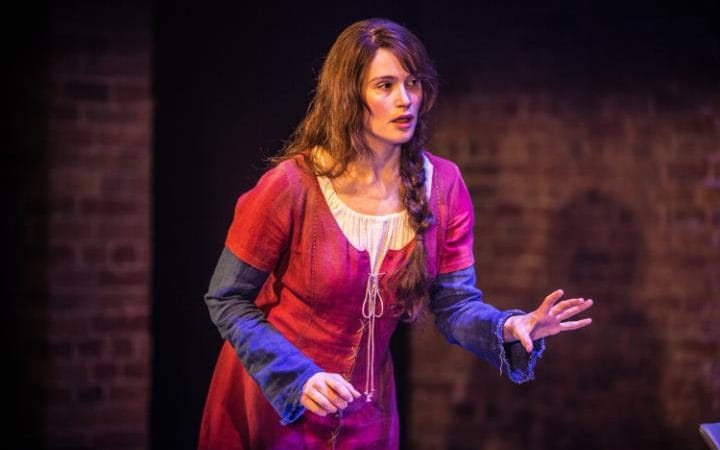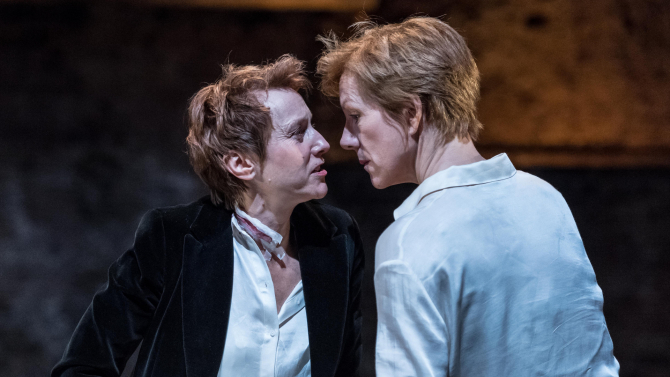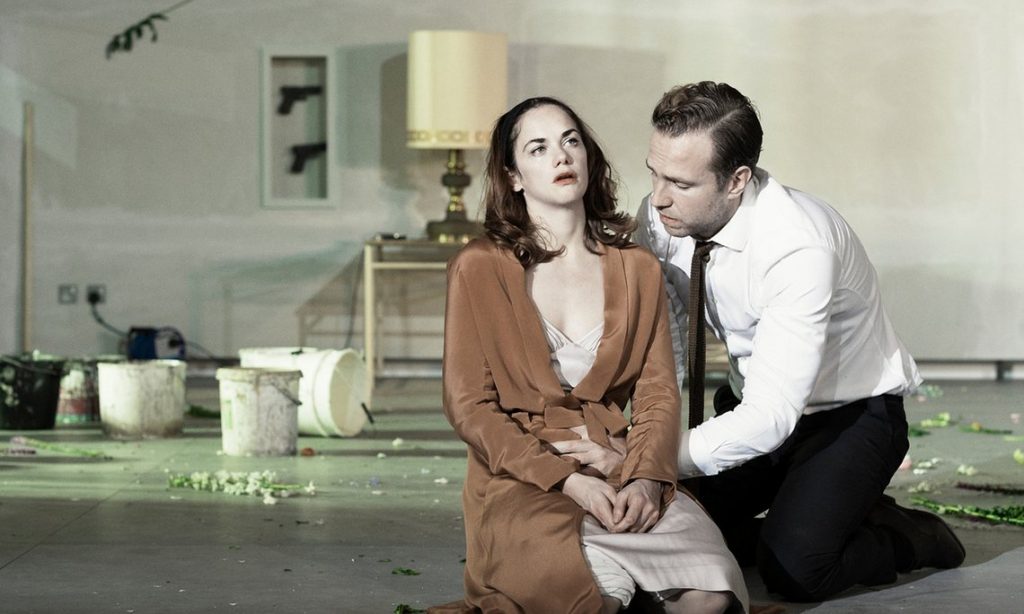by Carol Rocamora
Images of empowered women, protesting around the world, have flooded our screens this past weekend.
So the four powerful women from the past resurrected on London stages today have a thrilling relevance and resonance. As played by four formidable actresses in three classical revivals, their struggles couldn’t be more keenly felt, nor their courage more admired.
In Schiller’s Mary Stuart at the Almeida Theatre, we meet Elizabeth I, a queen with a king-sized problem. What should she do with her half-sister Mary Queen of Scots, imprisoned in the Tower for 19 years? Mary has become a political problem, and her death warrant sits before a conflicted Elizabeth, pressured from all sides to sign it (or not).
Robert Icke, a masterful adapter/director of the classics, has set this 1800 drama on a bare, oval-shaped stage, with his characters in contemporary dress. Moreover, he’s upped the dramatic stakes – at the top of every performance, the actresses (Juliet Stevenson and Lia Williams) enter, flip a coin, and whoever wins plays Elizabeth! This stunning opening keeps the audience on edge, as we watch Mary’s fate unfold.
As Elizabeth, Stevenson (who won the toss at the performance I attended) vacillates between imperiousness and indecision, while Williams (as Mary) used every wile she had (cunning, seduction, supplication, rage) to stay alive. To watch these masterful actresses engage in their violent struggle – and empathize with both – is a deeply emotional experience. ““I am a woman on my own, naked against the world,” agonizes Elizabeth. “Tell the Queen I love her as a sister,” says Mary, going proudly to her death. In the end we were the same.”
Another courageous woman from the fifteenth century is reigning on the Donmar Warehouse stage. She’s Saint Joan in George Bernard Shaw’s eponymous, feminist play – a woman warrior condemned to death for claiming that divine voices are guiding her to lead the French in battle against the British. As played by the charismatic Gemma Arterton in 15th century armor, the mighty Maid of Orleans is fearless against her opponents (the Church and various factions) played by actors in modern dress. She circles around their oblong glass conference table as they debate her fate. “Her death is a political necessity,” says Warwick, one of her many adversaries. “He who tells too much truth will be hanged,” responds this fearless heroine, whose martyrdom, like Mary’s, becomes a triumph.
Director Josie Rourke has staged the action on a bare, revolving stage, and, under broad video screens flashing news, Shaw’s dialogue comes alive. “What? Must I burn again”” Joan asks in her prophetic post-mortem epilogue. “Are none of you ready to receive me? How long, o Lord, how long?”
Yet another woman from the past is fighting for her life at the Royal National Theatre, in Ibsen’s Hedda Gabler (1890). This time, the heroine’s opponent is a suffocating, male-dominated society, in an updated interpretation directed by Ivo van Hove. When we first meet Ruth Wilson’s Hedda, this once-powerful woman (a general’s daughter, a pianist, an equestrian, a socialite) is reduced to a helpless captive in a loveless, middle-class marriage. Jan Versweyveld’s modern set offers Hedda a bleak white void that serves as her husband’s house….and her prison.
Van Hove’s trademark – stripping a classic down to the bone and offering shocking theatrical images – features a distracted Hedda stapling bouquets of flowers to the bare walls in a desperate gesture of domesticity. Later, clad only in a flimsy white slip (worn throughout the production), Hedda is doused with Bloody Marys by her husband’s friend Judge Brack, a cruel blackmailer (played by a sadistic Rafe Spall). Defiled and humiliated, no wonder Hedda is driven to self-destruction in the play’s final moment. It’s her only way of controlling her own destiny.
All these directors have updated their productions to underscore the play’s relevant theme of women and power. They’ve retained some classical elements, however – like the final image in Rourke’s modern-dress Mary Stuart when Elizabeth suddenly changes back into an elaborate 16th century gown. As Brother Martin says in Saint Joan: “This is not the end, my Lord, but the beginning.”
In London: Schiller’s Mary Stuart, adapted/directed by Robert Icke at the Almeida Theatre; Shaw’s Saint Joan, directed by Josie Rourke, at the Donmar Warehouse; Ibsen’s Hedda Gabler, in a version by Patrick Marber directed by Ivo van Hove, at the Royal National Theatre.





















